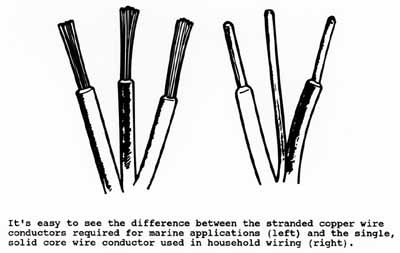Understanding Marine Power Systems
by Bill Drake


![]()
Power systems on a boat aren't the mystery that many make them out to be. Basic principles of electric theory are the same onshore or afloat, but conductors and their installation are different.
If a boat can accommodate household electrical conveniences, it undoubtedly has 2 entirely separate electrical systems. We at Marinco offer the following overview of the 2 systems.
The direct current (DC) system is powered from a storage battery or batteries. It provides power for the engine, bilge pumps, running lights, water pressure pump and other equipment.
The alternating current (AC) system power comes from a shoreside connection, on-board AC electrical generator or through an inverter. This system powers TVs, microwave ovens, hair dryers and the like but is very different from a household AC system.

Household conductors have solid core wire. The conductors used on a boat must be made of stranded copper wire to absorb the vibration typically found in boats. The conductor's proper size and diameter is determined by the amount of current the conductor must carry. As current increases, so must the size of the wire.
Good household wiring often travels through the house in plastic or metal tubing called conduit. It supports and protect the wires within the walls of a home. On a boat, conductors are supported by a self-draining loom or are secured every 18" by straps or clamps.
In most areas of a boat, non-metallic straps or clamps are ideal for holding conductors firmly in place. Insulated metal clamps are used in machinery spaces, areas which are hightemperature to minimize chafing damage.
Another difference between the 2 systems is where wires ar joined together. In a house splicing wire to wire is done by wire nuts. However, wire nuts must never be used on a boat.
Joining conductor to conductor in marine applications is best accomplished through the use of insulated, solderless crimp-on connectors. They assure continuity of current and won't be pulled apart when flexed. The connection may be covered with electrical tape, but electrical tape, by itself, should never be used to join 2 conductors.
Water is also a factor and keeping it out of a boat's system is paramount. Enclosures where connections are made - junction boxes, receptacles, panelboards - should be weatherproof or installed in protected locations. Current-carrying conductors
should be routed away from areas where water may accumulate.Following safety rules and using the finest marine electrical equipment and tools makes marine wiring relatively easy. Marinco, a leading manufacturer of marine electrical products, makes the products boaters need to tackle any marine electrical job. A Marinco dealer can help select parts suited for any boat.
From Marinco, 2655 Napa Valley Corporate Drive, Napa, CA 94558. Phone: 707-226-8600.
